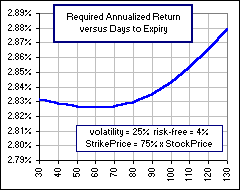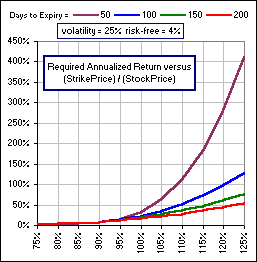| Call Options ... a continuation of Black-Scholes: Part III |
There's a magic formula for determining the Fair Price that one should pay for a call option.
>Formula?
Yes. See Black-Scholes formula
Indeed, if:
- S is the current stock price (example: S = $25)
- V is the volatility (example: V = 0.25 meaning 25%)
- R is the risk-free rate (example: R = 0.04 meaning 4%)
- T is the time to expiry (example: T = 0.5 years)
- K is the strike price (example: K = $22)
C = S*NORMSDIST((LN(S/K)+(R+V^2/2)*T)/(V*SQRT(T))) - K*EXP(-R*T)*NORMSDIST((LN(S/K)+(R+V^2/2)*T)/(V*SQRT(T))-V*SQRT(T))
>That looks terrible! I mean ...
Pay attention. In order to make money on the purchase of the option:
- the current stock price, $S, must increase to $K + $C before the expiry date.
- That means that the stock must increase by a factor of (K+C)/S in T years.
- That means that the stock must increase at an annual rate of {(K+C)/S}1/T - 1
- If Black-Scholes is an good estimate of the call premium, then, if we set
k = K/S we get {(K+C)/S}1/T - 1 = (k + C/S)1/T - 1 and if we then use the B-S formula to determine C/S, we get an expression for the Required Annualized Return (in order that the option expires with a stock price where you'd make money):
{ k + NORMSDIST((LN(1/k)+(R+V^2/2)*T)/(V*SQRT(T)))
- (1/k)*EXP(-R*T)*NORMSDIST((LN(1/k)+(R+V^2/2)*T)/(V*SQRT(T))-V*SQRT(T)) }1/T - 1
|
If we assume, for example, that V = 0.25 and R = 0.04 then we can investigate how the
Required Annualized Return depends upon T (the time to expiry) and k (the ratio
StrikePrice/StockPrice).
For example, Figure 1 shows what happens when k increases (for various values
of T = time to expiry) It appears that, if we buy an option with a StrikePrice well above the StockPrice (that's out-of-the-money) then we're expecting huge stock price increases. If we look more closely at the graph when (StrikePrice)/(StockPrice) is under 100%, we get Figure 2 which suggests that we should buy in-the-money call options ... where the StrikePrice is, say 75% - 80% of the current StockPrice.
Suppose we decide to buy an option with StrikePrice = 75% x StockPrice.
The chart below is then quite intesting.
 Figure 3 |
 Figure 1  Figure 2 |
>Are you saying I should buy options with a small strike price? Isn't that a theoretical suggestion? Do call options actually obey the Black-Scholes ...?
Okay. Let's look at Microsoft, today (July 9/02) and consider options which expire in October - about 100 days - and we see the following:

|
Let's look at options with Strike Prices of $25, $35, $45 and $55.
If, for example, we buy a $25 option and pay $29, then the stock must increase to $25+$29
= $54.00
by expiry (in 101 days or 101/365 = 0.277 years). That means an equivalent ANNUAL increase of
(54.00/53.93)1/0.277 - 1 = 0.0047 or 0.47%
On the other hand, if we go with the $55 option, paying $4.50, then the stock must increase to $55+$4.50 = $59.50 which means an ANNUALized increase of (59.50/53.93)1/0.277 - 1 = 0.426 or 42.6%.
On the other hand, if we ...
>And what does BLACK-SCHOLES say?
If we choose an appropriate Volatility (45%) and Risk-free Rate (4%) we get ANNUALized
returns pretty close to the actual ...
>Picture?
Yes.

>So, what are the chances that the stock price will be in the money?
At expiry? Good question.
Suppose:
- The stock has a (historical) Mean Annual Return of 9% and the Standard Deviation (of Annual Returns) is 25%.
- The Annualized Return is then (approximately) SQRT[1.092 - 0.252]
- For an option which expires in 100 days, or 100/365 = 0.274 years, the expected Return
isn't 9%, of course,
but (1.09)0.274 - 1 = 0.024 or 2.4%. Further, the SD for 100 days (or 0.274 years) isn't 25% but 25*SQRT(0.274) = 13%.


